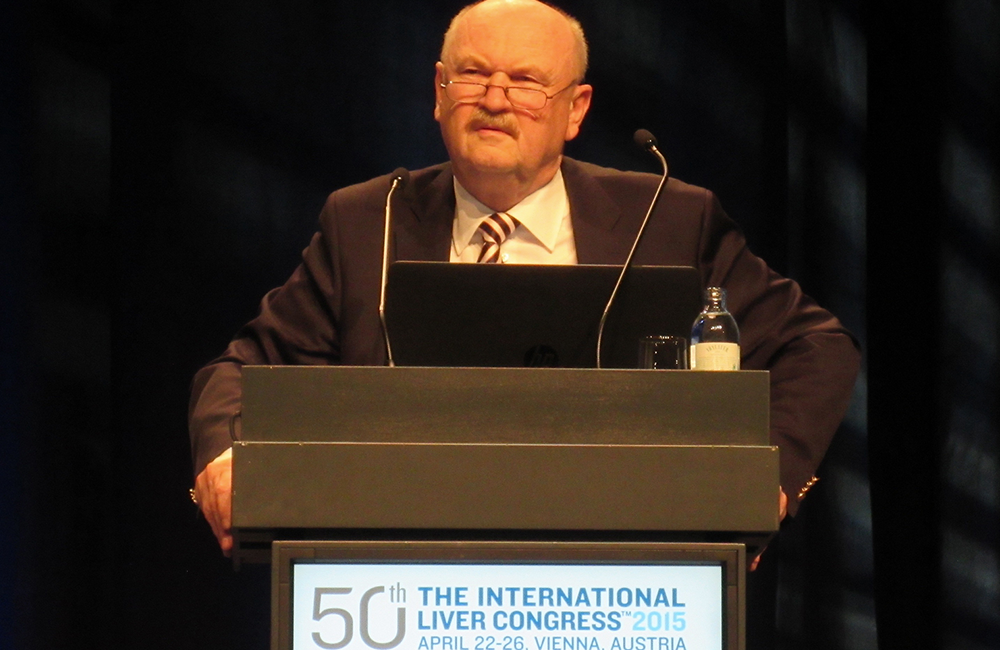
An oral regimen of sofosbuvir/ledipasvir (Harvoni) and ribavirin taken for 12 or 24 weeks produced sustained virological response (SVR) rates of 85-88% for people with genotype 1 or 4 hepatitis C virus (HCV) who had decompensated cirrhosis and 95-98% for liver transplant recipients with less advanced liver damage, according to results from the SOLAR-2 study presented yesterday at the European Association for the Study of the Liver (EASL) 50th International Liver Congress in Vienna, Austria.
Direct-acting antiviral agents in interferon-free regimens have revolutionised hepatitis C treatment, curing hepatitis C for most people, including those traditionally considered difficult to treat. But challenges remain for people with advanced liver disease, including those with decompensated cirrhosis (when the liver can no longer carry out its vital functions) and people who are awaiting or have received liver transplants.
Michael Manns of Hannover Medical School in Germany and fellow investigators with the SOLAR-2 trial evaluated the safety and efficacy of the nucleotide HCV polymerase inhibitor sofosbuvir and NS5A inhibitor ledipasvir, taken as a once-daily fixed-dose coformulation, plus daily ribavirin for people with advanced liver disease.
This phase 2 study enrolled more than 300 people with chronic hepatitis C in Europe, Canada, Australia and New Zealand. Three-quarters were men, more than 90% were white and the median age was nearly 60 years. Most had HCV genotype 1 (about half with 1a and 40% with 1b) while about 10% had genotype 4. About 80% had received prior treatment without being cured.
SOLAR-2 included 160 people with decompensated cirrhosis who were either awaiting or had received liver transplants. They were classified as Child-Pugh-Turcotte (CPT) class B or C, an index of liver disease severity based on bilirubin and albumin levels, blood clotting capacity and presence of ascites or hepatic encephalopathy. About one-quarter of the CPT B/C patients had a MELD score greater than 15 (another measure of liver disease severity). The study also included 168 liver transplant recipients with recurrent HCV who had less severe liver disease – CPT Class A and absent to advanced liver fibrosis (stage F0-F3).
Participants were randomly assigned to receive sofosbuvir/ledipasvir plus ribavirin for either 12 or 24 weeks. Manns explained that when the study was designed it was not yet known how well sofosbuvir/ledipasvir without ribavirin would work for people with advanced disease, so there was no ribavirin-free arm.
Preliminary results showed that after 12 weeks of post-treatment follow-up, the CPT B/C patients had sustained virological response (SVR12) rates of 85% with 12 weeks of treatment and 88% with 24 weeks. In the CPT A group, SVR12 rates were 95% and 98%, respectively. A single genotype 1 CPT A patient, six genotype 1 CPT B/C patients and three genotype 4 CPT B/C patients relapsed after finishing treatment.
Overall cure rates were similar for 12 and 24 weeks of therapy. Participants with CPT B responded somewhat better than those with CPT C, and within the CPT C group pre-transplant patients did better than post-transplant patients.
Looking only at the people with HCV genotype 1, the SVR12 rates were similar to the overall rates. Among genotype 4 CPT B/C patients, however, only 57% were cured with 12 weeks of therapy, rising to 86% with 24 weeks; the corresponding rates were 91% and 100% for genotype 4 CPT A patients. Mann cautioned that the genotype 4 numbers were too small to make meaningful comparisons, though he suggested that 24 weeks is probably preferable for genotype 4.
Sustained viral suppression was associated with improved liver function. Almost all CPT class A participants remained the same, 35% of those initially classified as class B reverted to class A, while 48% of those classified as class C reverted to class B and 5% to class A. CPT and MELD scores fell largely due to decreased bilirubin and improved ability to synthesise proteins such as albumin.
Given that this was a population with advanced disease, almost all participants experienced some adverse events. About 15% of CPT A patients and 28% of CPT B/C patients had serious adverse events, but only a few cases were deemed related to the study drugs. Twelve participants died during the study – mostly due to liver-related complications – but no deaths were considered treatment-related. Six people discontinued treatment due to adverse events, all but one of whom had decompensated cirrhosis. The most common adverse events were fatigue, anaemia, nausea and headache.
Sofosbuvir/ledipasvir plus ribavirin "resulted in high SVR12 rates in HCV patients with advanced liver disease, irrespective of transplantation status," the researchers concluded. They added that this regimen "was generally safe and well-tolerated in patients with advanced liver disease, pre- and post-liver transplantation."
Looking at another group of patients with advanced liver disease, a late-breaking poster presentation by Xavier Forns and colleagues described 11 participants in SOLAR-1 and SOLAR-2 who developed fibrosing cholestatic hepatitis, a rare severe form of recurrent hepatitis that can occur after liver transplantation. All of these patients achieved SVR12 after 12 or 24 weeks of treatment with sofosbuvir/ledipasvir plus ribavirin, according to a press release issued by manufacturer Gilead Sciences.
"The patients included in these analyses are among the most difficult to both treat and cure and, until now, have had limited or no treatment options," Mann stated in the release, commenting on both studies. "These data demonstrate that, even among these difficult-to-treat patient groups, sofosbuvir-based oral therapy offers the potential of high cure rates, improves outcomes and is generally well tolerated with a favourable safety profile."
Manns M et al. Ledipasvir/sofosbuvir with ribavirin is safe and efficacious in decompensated and post liver transplantation patients with HCV infection: preliminary results of the prospective SOLAR 2 trial. EASL 50th International Liver Congress, Vienna, abstract G02, 2015.
Forns X et al. Ledipasvir/sofosbuvir with ribavirin for the treatment of fibrosing cholestatic hepatitis C after liver transplantation. EASL 50th International Liver Congress, Vienna, abstract P0779, 2015.
Gilead Sciences. Gilead’s Harvoni and Sovaldi Demonstrate Efficacy and Safety among Chronic Hepatitis C Patients with Advanced Liver Disease. Press release. April 23, 2015.
